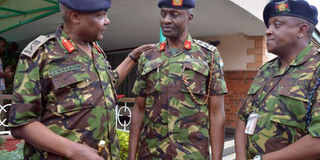Dodging bullets and bombs while covering the war

Vice Chief of the Kenya Defence Forces Lieutenant General Joseph Kasaon (left) chats with Chief Recruiting Officer Brigadier Kiugu Muthuri (center) and Public Affairs Office Lieutenant Colonel Paul Njuguna at Department of Defence in Nairobi on September 19, 2016. There are few journalists on the ground to offer an account of how KDF is carrying out its activities in Somalia. PHOTO | DENNIS ONSONGO | NATION MEDIA GROUP
What you need to know:
- In one of the instances, Shabaab militants shot so close to an Armoured Personnel Carrier ferrying troops and journalists that Mr Macharia almost went into a panic attack.
- About eight months ago, thousands of Al-Shabaab militants overrun a military base in El Adde.
On my third trip to cover the onslaught against Al-Shabaab in Somalia in 2012, driving in a convoy of three cars we encountered three ambushes in the short stretch from Dobley to Tabda.
The Somali militants would typically spray the convoy with bullets after improvised explosive devices placed along the road exploded.
On the first day inside Somalia while embedded with the Kenya Defence Forces (KDF), I counted over six bodies of militants, young and old, fat and slim carrying new guns but wearing old and torn clothes, almost all without shoes.
Even with the bullet-riddled bodies, those whose heads were not blown off still seemed to have a smile on their faces.
For the last five years, almost two dozen Kenyan journalists have risked their lives to cover the war.
Some of the notable names include John Ngirachu, Franklin Macharia, Mauritius Oduor, Mike Njenga, Wilson Raburu, Govedi Asutsa, Dann Okoth, Murithi Mutiga, William Oeri, Jared Nyataya, Muchemi Wachira, Mohamed Ali and John Allan Namu.
Many of them have come close to death. In one of the instances, Shabaab militants shot so close to an Armoured Personnel Carrier ferrying troops and journalists that Mr Macharia almost went into a panic attack.
While in Somalia, we slept inside bunkers and when we came back home told the tales of the war as it happened detailing all the sights, sounds, the bombings, and the mosquitoes and hyenas that conspired to give us sleepless nights.
During the first months of the war, the reporting was quite misleading with a number of journalists telling readers and viewers that the military was “almost approaching Kismayu and that the war could soon be over.”
The reason was that most of us had no experience covering a war. It was the first time that Kenya was going into war.
If asked why I went to Somalia, I could say it was out of excitement and adventure, and being a member of an exclusive club, that of combat correspondent.
However, the excitement went down because while even at the battleground KDF controlled “your life”.
END OF ROAD
Only the military could transport you, give you food and even a phone to call home.
Quite a handful of those embedded were from that special school of journalism that admonished, “If your mother says she loves you, check it out”.
After redeployment of Col Cyrus Oguna from the Communications Department at DoD, the military started blaming the media for their slowed conquests in Somalia.
These days, KDF hardly accommodates requests for journalists to go to Somalia.
It is probably one of the most restricted wars in the world.
And this might have undermined the KDF because even its thundering victories, such as the seaborne assault on Kismayu, were barely reported because there were no independent journalists on the ground.
About eight months ago, thousands of Al-Shabaab militants overrun a military base in El Adde.
By the end of two days, before the first team of Kenyan troops arrived too late for a rescue mission, they had killed almost 200 soldiers, Amisom’s worst single attack.
But no one saw in pictures the horrors of war deaths or read in words the fear and anguish of those who survived.
The two or three dozen men who survived out of a Company Force of about 230 men have been gagged and told not to speak about it.
Five years after the war began, there are few journalists on the ground to offer an account of what is happening in the war theatre.





